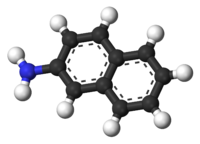2-Naphthylamine
 |
|
 |
|
| Names | |
|---|---|
|
Preferred IUPAC name
Naphthalen-2-amine
|
|
| Other names
(Naphthalen-2-yl)amine
2-Naphthylamine β-Naphthylamine |
|
| Identifiers | |
|
91-59-8 |
|
| 3D model (Jmol) | Interactive image |
| ChEBI |
CHEBI:27878 |
| ChEMBL |
ChEMBL278164 |
| ChemSpider |
6790 |
| ECHA InfoCard | 100.001.892 |
| KEGG |
C02227 |
|
|
|
|
| Properties | |
| C10H9N | |
| Molar mass | 143.19 g·mol−1 |
| Appearance | White to red crystals |
| Odor | odorless |
| Density | 1.061 g/cm3 |
| Melting point | 111 to 113 °C (232 to 235 °F; 384 to 386 K) |
| Boiling point | 306 °C (583 °F; 579 K) |
| miscible in hot water | |
| Vapor pressure | 1 mmHg (107° C) |
| Acidity (pKa) | 3.92 |
| -98.00·10−6 cm3/mol | |
| Hazards | |
| Flash point | 157 °C; 315 °F; 430 K |
| Related compounds | |
|
Related compounds
|
2-Naphthol |
|
Except where otherwise noted, data are given for materials in their standard state (at 25 °C [77 °F], 100 kPa).
|
|
|
|
|
| Infobox references | |
2-Naphthylamine is one of two isomeric aminonaphthalenes, compounds with the formula C10H7NH2. It is a colorless solid, but samples take on a reddish color in air because of oxidiation. The aromatic amine used to be used to make azo dyes. It is a known carcinogen and has largely been replaced by less toxic compounds.
2-Naphthylamine is prepared by heating 2-naphthol with ammonium zinc chloride to 200-210 °C, the Bucherer reaction. It also can be produced its acetyl derivative by heating 2-naphthol with ammonium acetate to 270-280 °C.
It gives no color with iron(III) chloride. When reduced by sodium in boiling amyl alcohol solution, it forms tetrahydro-3-naphthylamine, which exhibits the properties of the aliphatic amines in that it is strongly alkaline in reaction, has an ammoniacal odor and cannot be diazotized.
On oxidation, it yields ortho-carboxy-hydrocinnamic acid, HO2CC6H4CH2CH2CO2H.
Numerous sulfonic acid derivatives of 2-naphthylamine are used in commerce, such as precursors to dyes. Owing to the carcinogenicity of the amine, these derivatives are mainly prepared by amination of the corresponding naphthols. Of them, the δ-acid and Bronner's acid are of more value technically, since they combine with ortho-tetrazoditolyl to produce fine red dye-stuffs.
...
Wikipedia
